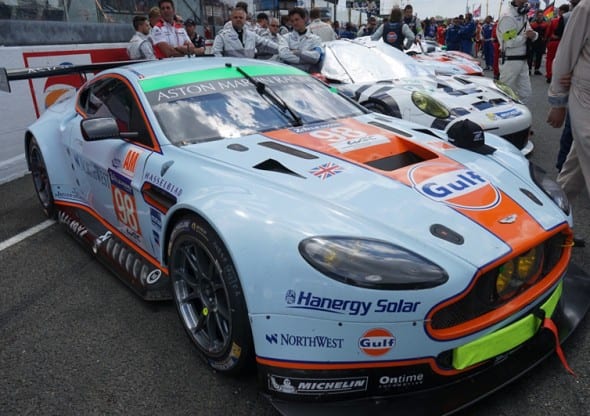A UK-based effort to develop the world’s first commercially available solar power integrated car has been renewed, as part of a partnership between Aston Martin Racing and Chinese solar giant Hanergy, formed last June.
The British racing team and world’s largest thin-film solar company said on Monday they would continue efforts to develop the capability and effectiveness of Hanergy’s panels for use in the consumer automobile market.
Back in in June, Hanergy said it wanted to adapt its thin-film solar cells so that they could be applied to the roof or rear windscreen of cars, to power their air-conditioning and other functions without affecting performance or using the fuel or battery source.
The deal with Aston Martin Racing to fix thin-film panels to its GET model – which would both put the panels to an extreme test, while exploring how the sun’s energy would be used to improve the comfort level and performance of a race car – was signed just before the car’s victory in the GTE Am class at the FIA World Endurance Championship (WEC).
 At this stage, the solar modules are used to charge the car’s main battery, which powers a number of functions inside the car, including its air conditioning system.
At this stage, the solar modules are used to charge the car’s main battery, which powers a number of functions inside the car, including its air conditioning system.
This year, it is hoped that improvements to the panels’ power output will further enable the car’s alternator to be used less frequently, reducing its demands on the engine and consequently improving its performance under race conditions.
“The more electrical energy we generate from the solar panels, the more of the engine’s output can be used to power the car, ultimately improving its performance,” said Aston Martin Racing technical director Dan Sayers in a statement.
According to Hanergy vice president Jason Chow, the panels’ current output can still be increased significantly.
“Theoretically we can get 300W which is an increase of 300% on the current output,” he said. “These are still early days for us, and our work for the following year will focus on maximising power output from panels that can fit a typically sized car roof, c. 1m squared.”
For Hanergy, the collaboration has also resulted in several panel improvements, including durability in all weather conditions and resistance to vibrations when the car is moving at high speeds.
Beyond this experiment, Hanergy has plans to expand its project to a wider range of car models.
“We are starting with luxury and high performance cars like the Aston Martin GTE to test our limits and understand performance at high speeds,” Chow said.
“As we develop our technology further, we plan to adapt our panels to electric, hybrid and petrol and diesel powered cars accessible to the public.”










